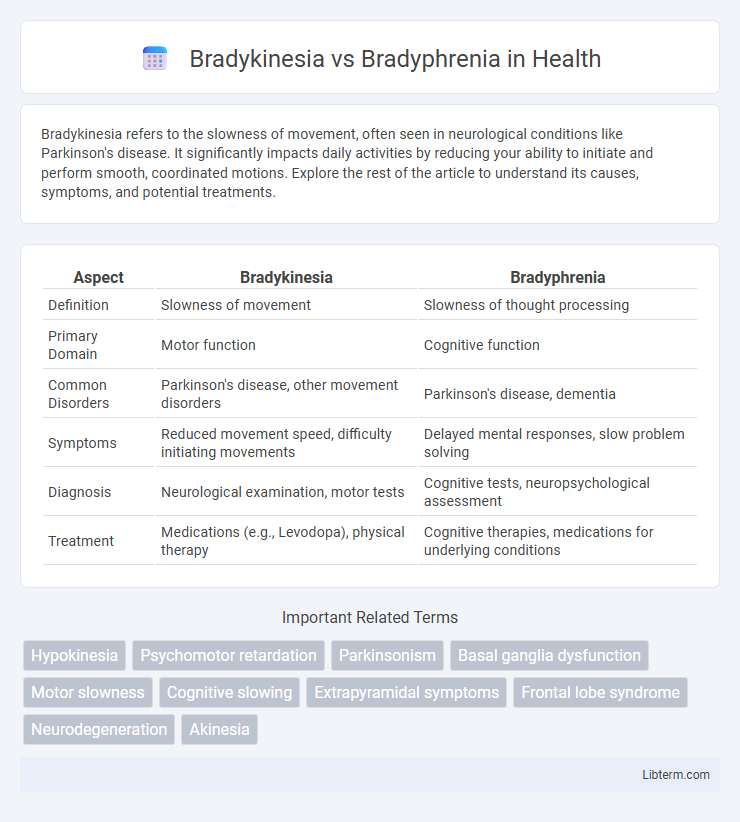Bradykinesia refers to the slowness of movement, often seen in neurological conditions like Parkinson's disease. It significantly impacts daily activities by reducing your ability to initiate and perform smooth, coordinated motions. Explore the rest of the article to understand its causes, symptoms, and potential treatments.
Table of Comparison
| Aspect | Bradykinesia | Bradyphrenia |
|---|---|---|
| Definition | Slowness of movement | Slowness of thought processing |
| Primary Domain | Motor function | Cognitive function |
| Common Disorders | Parkinson's disease, other movement disorders | Parkinson's disease, dementia |
| Symptoms | Reduced movement speed, difficulty initiating movements | Delayed mental responses, slow problem solving |
| Diagnosis | Neurological examination, motor tests | Cognitive tests, neuropsychological assessment |
| Treatment | Medications (e.g., Levodopa), physical therapy | Cognitive therapies, medications for underlying conditions |
Understanding Bradykinesia: Definition and Symptoms
Bradykinesia is characterized by the noticeable slowness of voluntary movement, commonly observed in Parkinson's disease, resulting in difficulty initiating and executing motions. Symptoms include reduced facial expression, decreased arm swing while walking, and overall muscle rigidity, which lead to impaired motor function and daily activity challenges. Unlike bradyphrenia, which involves slowed cognitive processing, bradykinesia primarily affects motor control and physical movement speed.
Bradyphrenia Explained: Meaning and Key Features
Bradyphrenia refers to the slowing of thought processes often observed in neurological conditions such as Parkinson's disease and Alzheimer's disease, characterized by delayed cognitive responses and reduced mental agility. Key features include impaired problem-solving, difficulty in information processing, and decreased verbal fluency, distinguishing it from Bradykinesia, which primarily affects physical movement speed. Understanding Bradyphrenia is crucial for accurate diagnosis and targeted cognitive rehabilitation strategies in affected patients.
Neurological Origins: What Causes Bradykinesia and Bradyphrenia?
Bradykinesia is primarily caused by dysfunction in the basal ganglia, particularly the substantia nigra, leading to dopamine depletion as seen in Parkinson's disease. Bradyphrenia results from cortical and subcortical brain changes, often linked to neurodegenerative conditions such as Alzheimer's disease or frontotemporal dementia. Both conditions reflect distinct neurological impairments affecting motor and cognitive processing speeds respectively.
Differentiating Bradykinesia from Bradyphrenia
Bradykinesia refers to the slowing of physical movement commonly seen in Parkinson's disease, characterized by delayed initiation and execution of voluntary motor actions. Bradyphrenia involves slowness of thought processes, affecting cognitive functions such as attention, processing speed, and decision-making, typical in conditions like dementia or depression. Differentiating bradykinesia from bradyphrenia requires clinical assessment of motor symptoms versus cognitive slowing, often using specialized neuropsychological tests alongside motor function evaluations.
Diagnostic Criteria: How Are Bradykinesia and Bradyphrenia Identified?
Bradykinesia is diagnosed primarily through clinical observation of slowed and decreased movement amplitude, assessed using tools like the Unified Parkinson's Disease Rating Scale (UPDRS), while bradyphrenia is identified by neuropsychological tests revealing slowed cognitive processing and impaired mental speed. Bradykinesia often presents with symptoms such as reduced facial expression, difficulty initiating movement, and decreased arm swing, whereas bradyphrenia manifests as slowed thought, attentional deficits, and delayed reaction times during cognitive tasks. Neuroimaging and electrophysiological studies may support differentiation by highlighting basal ganglia dysfunction in bradykinesia and cortical-subcortical network alterations in bradyphrenia.
Common Conditions Associated with Bradykinesia and Bradyphrenia
Bradykinesia is commonly associated with Parkinson's disease, characterized by slowness of movement, muscle rigidity, and tremors, often leading to significant motor impairment. Bradyphrenia, marked by slowed cognitive processing, is frequently observed in neurodegenerative disorders such as Parkinson's disease dementia, Lewy body dementia, and Alzheimer's disease. Both conditions reflect underlying basal ganglia dysfunction but affect motor and cognitive domains, respectively, highlighting distinct but overlapping clinical presentations in movement and cognitive disorders.
Impact on Daily Life: Motor vs Cognitive Impairment
Bradykinesia significantly impairs daily activities by slowing motor functions such as walking, dressing, and eating, leading to challenges in physical mobility and coordination. Bradyphrenia predominantly affects cognitive processing speed, resulting in difficulties with attention, decision-making, and problem-solving tasks essential for daily functioning. Both conditions reduce quality of life but target distinct domains: bradykinesia disrupts physical actions, while bradyphrenia hampers mental efficiency.
Therapeutic Approaches for Bradykinesia
Bradykinesia, characterized by slowness of movement primarily due to Parkinson's disease, is often managed therapeutically with dopaminergic medications such as levodopa and dopamine agonists that enhance dopamine levels in the brain. Physical therapy programs focusing on motor exercises, gait training, and resistance techniques are crucial to improve mobility and functional independence. In contrast, bradyphrenia, which involves slowed cognitive processing, typically requires cognitive rehabilitation and pharmacological strategies targeting underlying neurological conditions rather than dopamine replacement.
Treatment Strategies for Bradyphrenia
Treatment strategies for bradyphrenia primarily involve cognitive rehabilitation therapies targeting slowed mental processing and executive dysfunction. Pharmacological interventions may include the use of cholinesterase inhibitors or stimulants like methylphenidate to enhance cognitive alertness and processing speed. Combining cognitive behavioral therapy with supportive psychosocial measures further aids in managing symptoms and improving quality of life for patients with bradyphrenia.
Prognosis and Quality of Life: Comparing Outcomes
Bradykinesia, characterized by slowed movement often seen in Parkinson's disease, primarily impacts motor function and can lead to decreased mobility and independence, significantly affecting quality of life and necessitating long-term management strategies. Bradyphrenia, defined as slowed cognitive processing speed, frequently occurs in neurodegenerative disorders like dementia, leading to impaired decision-making and communication challenges that profoundly influence daily functioning and prognosis. While both conditions contribute to reduced quality of life, bradykinesia's prognosis depends largely on motor symptom control, whereas bradyphrenia prognosis is tied to cognitive decline progression, often resulting in more complex care needs.
Bradykinesia Infographic

 libterm.com
libterm.com